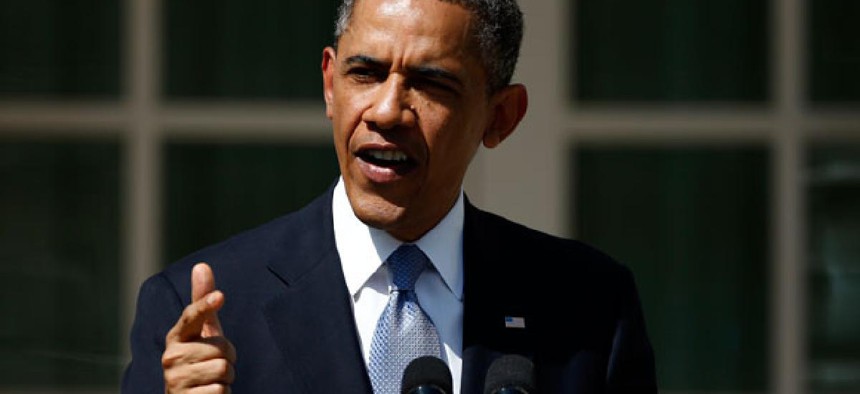Obama Seeks Slight Increase in Tech Spending for Fiscal 2014

Charles Dharapak/AP
The president’s proposed budget includes a 2 percent hike for IT.
This story has been updated.
President Obama’s fiscal 2014 budget hikes information technology spending slightly to $82 billion, a 2 percent increase from estimated fiscal 2012 levels.
Much of that increase comes from a 22 percent jump in proposed IT spending at the Veterans Affairs Department, focused mainly on reducing VA’s disability claims backlog and improving electronic outreach to veterans, federal Chief Information Officer Steven VanRoekel said in a conference call with reporters on Wednesday.
Another substantial part of the increase will go toward IT initiatives to improve border security managed by the Homeland Security Department, he said.
The 2 percent hike actually represents a spending reduction after accounting for inflation, VanRoekel said.
The White House’s overall strategy was to cut 10 percent of agencies’ IT spending, mostly by increasing bulk buying of IT commodities such as wireless and cell phone service, and then reinvesting that money in long term efficiency initiatives at the agency or governmentwide level, he said. That led to an essentially flat budget that new investments at VA and Homeland Security were added on top of, he said.
“The conversations I’ve been having with appropriators and authorizers on the Hill as well as with people at agencies is that now is the time to invest in IT and that will really have a multiplier effect in efficiency and effectiveness if it’s done well,” VanRoekel said.
The overall growth in government IT spending has declined significantly since President Obama took office. IT spending grew at about 7 percent annually from 2001 to 2009 and has grown at less than 1 percent annually since then.
This slowdown is due largely to greater oversight of large IT contracts, the shift to cloud storage for many government computing operations and increased bulk buying for commodity IT purchases such as wireless Internet and mobile phone purchases, VanRoekel said
The administration’s fiscal 2013 proposed budget slightly reduced IT spending to $79.1 billion, a dip it credited largely to spending cuts at the Defense Department. The 2014 proposed budget effectively returns defense IT spending to its 2012 level of about $40 billion.
Wednesday’s budget request included $6 million for a new “data driven innovation fund” run out of VanRoekel’s office. The fund will be aimed at helping agencies better analyze data to make smarter investments, he said.
The request also included $20 million for the E-government fund, managed by the General Services Administration, which funds initiatives that use the Internet and other electronic communications to improve citizen services and public access to government information.
That’s more than double the 2012 enacted funding of $8 million for E-gov. The administration has typically proposed significantly more e-gov funding than Congress ultimately approved. E-gov initiatives include the government dataset trove Data.gov and the Federal IT Dashboard, which tracks the performance of major government technology acquisitions.
Wednesday’s budget analysis pledges to double down on initiatives to improve return on investment for federal IT projects, provide better electronic services for citizens and to improve cyber protection.
The analysis also credited VanRoekel’s bulk buying initiative for commodity IT, known as PortfolioStat, with identifying $2.5 billion in potential savings and realizing $300 million in savings so far. The government expects to save $590 million through PortfolioStat by the end of 2013, VanRoekel said.
VanRoekel outlined a plan in March to expand PortfolioStat to focus on ensuring agency-level CIOs have sufficient authority over IT projects. Version two of PortfolioStat also refocuses the government’s four-year old initiative to consolidate federal data centers to focus on overall savings rather than the raw number of centers closed.






